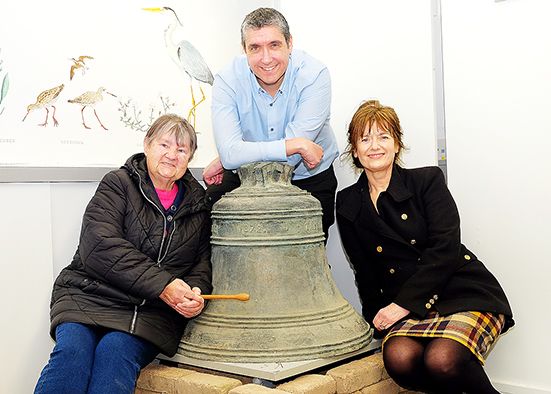Shrigley clock bell back within the community
Shrigley clock bell back within the community
8 February 2023

THE bell that was at the heart of Shrigley’s historic Martin Memorial clock has been handed back to the community — for now.
Once used to summon workers to the mill in the village, it has been gifted back to local people for display by the Housing Executive and is located in the Sir Hans Sloane Centre in Killyleagh.
News that the bell has been handed to the community comes after recent confirmation that a bid in the region of £500,000 for a share of the government’s Levelling Up Fund to restore the iconic clock was unsuccessful,
The Housing Executive — which owns the clock — helped prepare the funding application for a share of the Levelling Up Fund.
Having been left to rundown for decades, there was hope that at last the clock could be restored to its former glory with those supporting its restoration left disappointed by the government’s decision not to provide the much-needed financial support.
Housing officials had previously been in talks with a local interest group in relation to compiling a feasibility study to examine options and prepare design concepts for the area which would involve the acquisition and restoration of the Martin Memorial clock.
Dating back to the Victorian era, various calls have made over many decades for the clock to be restored to its former glory but no progress has been made.
Many are concerned to see the historic landmark falling into continued disrepair, but were hopeful that it could be restored to be enjoyed for generations to come, reinforcing its connection with the village’s industrial past.
And while the search for potential new funding options continues, the bell now sits at the Sir Hans Sloane Centre which is dedicated to one of Killyleagh’s famous sons.
The Housing Executive’s South Down assistant area manager, Niall Fitzpatrick, explained that over the years, the organisation explored options and funding with others to secure the restoration and long term sustainability of the clock tower.
“Recently, we were involved in an application for a Levelling Up Fund grant to help carry out the work necessary to return it to its former glory. Unfortunately, this was unsuccessful, but we remain open to speaking to any interested parties and examining any proposals,” he added.
Sir Hans Sloane Centre founder and chief executive, Dr Elizabeth Crilly, is delighted the Shrigley bell is now located at the High Street premises.
“We plan that the bell will draw in local people and other visitors to reminisce, or learn anew, the grand history of Shrigley during the industrial revolution and up to recent times,” she said.
“The story of the Martin Monument, as the clock tower is also known, is one of mutual respect and appreciation between employer and employee, and one where a strong community was built and prosperity shared.”
Dr Crilly said display boards of the village history and involving school students in creating models of Shrigley past are currently being produced with Centre officials looking to the future of how the monument can be restored and the area around it revitalised to become a community focus for the residents of Shrigley once again.
For more than a century and a half, the historic monument has been an integral part of Shrigley and holds a special place in the hearts of villagers.
Built in 1871, it was originally erected in the centre of the village by the workers to pay tribute to the Martin family who owned the old spinning factory.
The Housing Executive acquired the clock tower, designed by Belfast-born architect Timothy Hervey, when the old mill village was demolished and a new village built nearby in 1970.
The clock tower had its bell and interior mechanism removed over 30 years ago.
Gareth Morgan, whose family comes from Shrigley and who works for the Housing Executive, has taken a personal interest in the fate of the historic bell and tower.
His grandfather worked in the mill, while his father worked in the tannery which was established after the mill closed and produced light leathers and suedes.
“I feel a close connection to the monument,” he said.
“The area is full of history. The old spinning factory was powered by water supplied from the nearby Clea Lough and the mill reportedly employed 500 people in its heyday, so it was an extremely important feature in the village.”
Gareth said the bell hung in the tower from 1871 to 1976 and explained that when the Housing Executive inherited the property from the old East Down Council, the workings were lost and the bell removed.
He also revealed that in 1976, some restoration work was carried out on the bell which had been kept in a store in Marshallstown outside Downpatrick.
“Now, we have returned the bell safely to the community after being its custodians for so long,” Gareth added.


